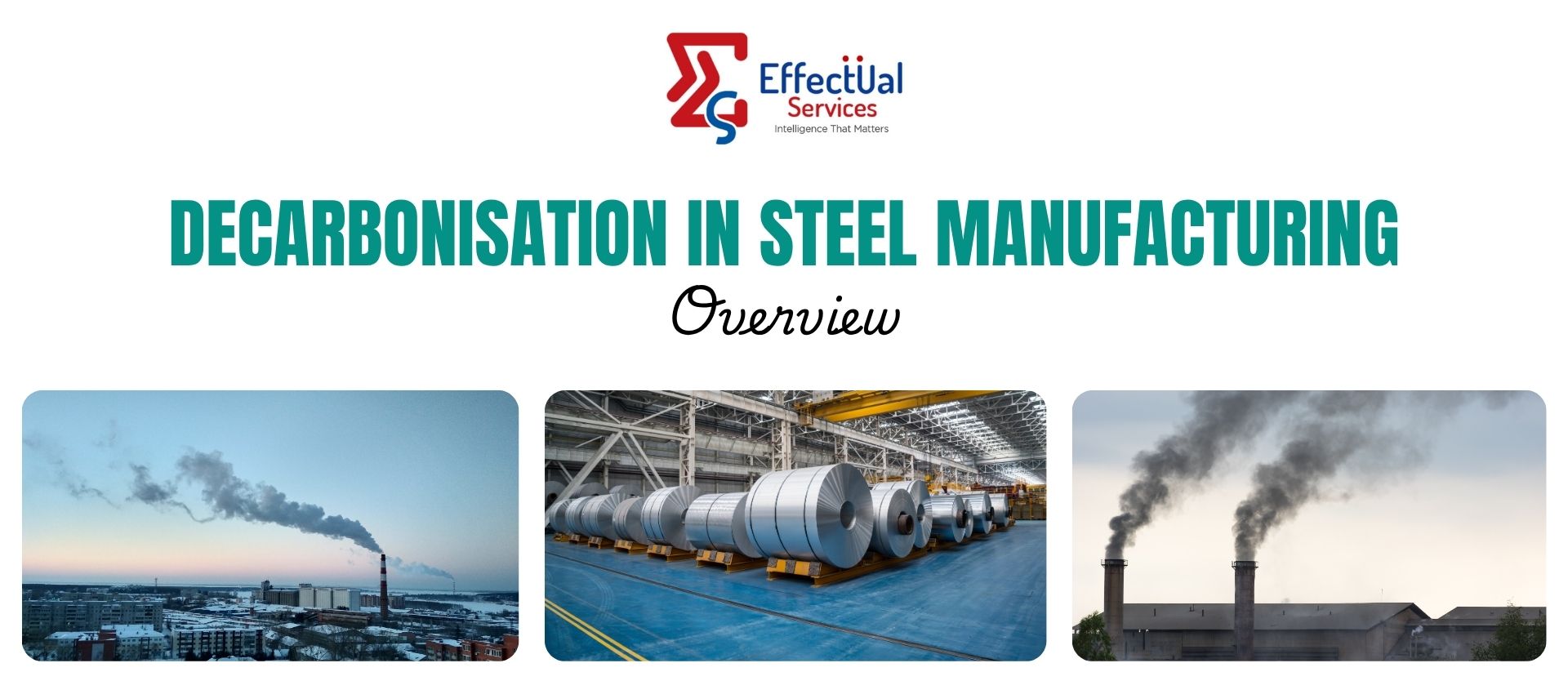Decarbonisation in Steel Manufacturing: Overview

Decarbonisation in Steel Manufacturing: Objective
Iron and steel products form the foundation of our modern lives. They are indispensable in the construction of buildings, skyscrapers, transportation systems, and various infrastructure. Even as we strive for a sustainable and low-carbon future, the demand for iron and steel remains significant.
However, the iron and steel industry is also one of the leading contributors to carbon emissions among heavy industries. Steel producers need to assess, evaluate, and decide on a technologically and economically viable decarbonisation technology to decrease their carbon footprint.
Steels are produced with the aim of reducing CO2 emission (decarbonisation) by the pathways of circular economy, smart carbon usage and carbon direct avoidance.
Steel can be manufactured via using an integrated blast furnace (BF)/basic oxygen furnace (BOF) or an electric arc furnace (EAF). While integrated players produce steel from iron ore and need coal as a reductant, EAF producers use steel scrap or direct reduced iron (DRI) as their main raw material. The iron and steel production process can be divided into five distinct steps: raw material treatment, iron making, steel making, casting, and rolling/finishing. The emissions, predominantly carbon dioxide (CO2), in iron and steel production primarily stem from the combustion of fossil fuels, use of electrical energy, and the utilization of coal and lime as feedstock. Steel making can adopt to decarbonization methods in order to reduce emissions, to get the new market opportunity, and to manage global regulation.
Decarbonization in steel manufacturing presents several challenges and problems that need to be addressed. These include:
- High Carbon Emission: The traditional steelmaking process, known as the blast furnace route, relies on the use of coal and coke as primary energy sources and reductants. This results in significant carbon dioxide (CO2) emissions. The carbon intensity of the steel industry is a major concern as it contributes to climate change and global warming.
- Limited Availability of Low-Carbon Alternatives: The widespread adoption of low-carbon alternatives and technologies in steel production is still limited. While processes like direct reduction and electric arc furnace (EAF) can reduce carbon emissions compared to the blast furnace route, they face challenges such as higher costs, and technological limitations.
- Technological Limitations: Implementing circular economy practices and smart carbon usage in steel production requires the development and deployment of advanced technologies. However, some of these technologies are still in the early stages of development, lacking scalability or commercial viability.
- Infrastructure and Technological Barriers: Upgrading existing facilities and implementing carbon capture and storage (CCS) technologies face economic and technical barriers, hindering their widespread adoption. The construction of carbon capture, utilization, and storage (CCUS) infrastructure also requires time, additional costs(upfront investment) to be developed at a significant scale
- Integration: Implementing decarbonization technologies on a large scale across the entire steel production process is a complex task. Integrating new technologies and processes into existing operations, retrofitting existing facilities, and ensuring smooth transitions without disrupting production pose significant challenges.
- Energy Intensity and Availability: Steel manufacturing is an energy-intensive process, requiring large amounts of heat and electricity. Transitioning to low-carbon green energy sources, such as renewable energy and hydrogen, poses challenges in terms of availability, reliability, and cost.
The production of steel relies on raw materials such as iron ore, coal, and limestone. Transitioning to alternative iron sources, such as direct reduced Iron Raw Material Supply: on (DRI), or adopting scrap-based steel production methods requires ensuring a sustainable supply of these materials. Additionally, the availability and quality of alternative materials can be a limiting factor.
Policy and Regulatory Frameworks: The successful decarbonization of the steel industry requires supportive policy and regulatory frameworks. Policies that incentivize and accelerate the adoption of low-carbon technologies, provide financial support, and establish clear targets and standards are crucial. Developing consistent and coordinated international policies is also important to ensure a level playing field and avoid carbon leakage.
The report answers the following questions
Recommendation on the Decarbonization in steel manufacturing process.
Recommendations that provide advanced feature of decarbonization in steel manufacturing technology/process and supported by proof of concept for advanced features includes:
- Commercially viability
- Large scalability.
- Cost effective.
- Less technology implementation/construction time.
- Simplified integration.
- Production of steel with renewable energy source (ex. hydrogen, solar and wind etc.)
- Reduce the use of fossil fuel (e.g. coal)
- Carbon Capturing and re-using carbon-rich waste gases to make valuable chemical products.
About Effectual Services
Effectual Services is an award-winning Intellectual Property (IP) management advisory & consulting firm offering IP intelligence to Fortune 500 companies, law firms, research institutes and universities, and venture capital firms/PE firms, globally.
Through research & intelligence we help our clients in taking critical business decisions backed with credible data sources, which in turn helps them achieve their organisational goals, foster innovation and achieve milestones within timelines while optimising costs.
Solutions Driving Innovation & Intelligence
Enabling Fortune 500's, R&D Giants, Law firms, Universities, Research institutes & SME's Around The Globe Gather Intelligence That
Protects and Nurtures Innovation Through a Team of 250+ Techno Legal Professionals.

